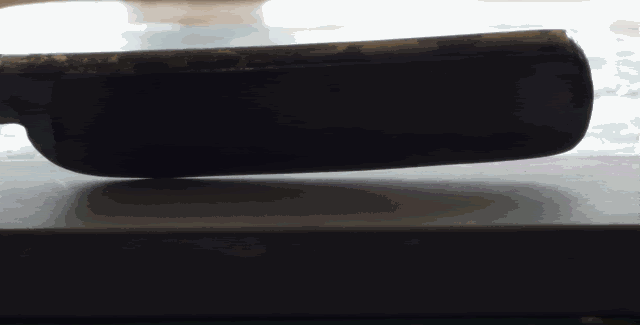Smythe
Well-Known Member
We often note the condition of the edge (before honing)… that is: pitting, chips, cracks warps, “dullness” and other such nuisance that would make sharpening or shaving difficult. However we seldom consider the profile of the edge… that is, the average “line” formed by the edge from heel to point. I believe the line or “shape” of the edge has great effect on the performance of the resulting edge. Unfortunately, the true shape of the edge when looking at the blade face-side, is not always obvious at first glance, a slight frown, almost invisible, will often result with a “lacking comfort” even after the best honing effort.
For example: (other things considered) with a frown most of the middle of the edge does not make good contact with the surface of the hone, this is because the middle is held-up off the surface by the hi spots (in this case the Heel and Point)… it’s almost like the “trough” side of a warped blade… the middle fails to make good contact the surface during the stroke, however, unlike a warped blade, nether side of a frown makes proper contact with the hone and the resulting edge just won’t “cut it”.
Note: a warped blade is not such a bad thing; with the proper technique can easily be honed, but it does help if you know it exists, however the physics, and thus technique of sharpening a blade in either condition is a little different… In other words, one condition you need to fix before successful sharpening, the other you cannot fix but you can still sharpen it successfully.
Note: A warp can indeed cause a frown to form at the edge (things do get complicated), but so long as you are aware of the condition your chance of success increase 10 fold.
As mentioned earlier the high spots are in firm contact with the surface of the hone, but the low spots are set back from the average line of the edge, nearer to the spine and thus is held up off the hone, not by much, only a few microns may be enough to prevent contact.
This text is getting long winded so without further delay lets move on to some examples in photos of a typical selection of “Not Yet Restored or Sharpened” auction acquisitions, let’s examine them one at a time.
For example: (other things considered) with a frown most of the middle of the edge does not make good contact with the surface of the hone, this is because the middle is held-up off the surface by the hi spots (in this case the Heel and Point)… it’s almost like the “trough” side of a warped blade… the middle fails to make good contact the surface during the stroke, however, unlike a warped blade, nether side of a frown makes proper contact with the hone and the resulting edge just won’t “cut it”.
Note: a warped blade is not such a bad thing; with the proper technique can easily be honed, but it does help if you know it exists, however the physics, and thus technique of sharpening a blade in either condition is a little different… In other words, one condition you need to fix before successful sharpening, the other you cannot fix but you can still sharpen it successfully.
Note: A warp can indeed cause a frown to form at the edge (things do get complicated), but so long as you are aware of the condition your chance of success increase 10 fold.
As mentioned earlier the high spots are in firm contact with the surface of the hone, but the low spots are set back from the average line of the edge, nearer to the spine and thus is held up off the hone, not by much, only a few microns may be enough to prevent contact.
This text is getting long winded so without further delay lets move on to some examples in photos of a typical selection of “Not Yet Restored or Sharpened” auction acquisitions, let’s examine them one at a time.
